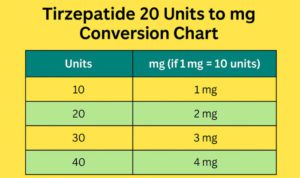
A lot of people wonder: how many mg is 20 units of tirzepatide? It’s a simple question, but the answer isn’t always clear—especially if you’re using different pens or vials. The truth is that the amount in mg depends on the strength of your specific tripeptide. Getting this wrong can lead to taking too much—or not enough. If you want to know more about Tirzepatide dosage, you can read this first “Tirzepatide Dosage and Unit Conversation Guide“.
In this guide, we’ll explain exactly what 20 units means, how to calculate the dose safely, and what you need to know before your next injection. Let’s make it simple together.
What does 20 units of Tirzepatide actually mean?
When someone says they’re taking 20 units of tirzepatide, it sounds simple—but there’s more to it. “Units” don’t directly mean milligrams. Instead, units measure how much liquid you’re injecting, not the actual strength of the medicine inside.
The real amount of tirzepatide (in mg) depends on how strong the medicine is in each unit. For example, one person’s 20 units could be 10 mg, while someone else’s might be 20 mg. That’s why it’s so important to understand what your vial or pen contains before taking it.
Unit to mg Conversion: How many mg in 20 units?
If you’re taking 20 units of tirzepatide, that doesn’t always mean the same mg for everyone. It depends on how strong your medicine is. For example, if 1 mg equals 10 units, then 20 units mean 2 mg. So, the mg amount changes based on your injection’s strength. Always check your pen or vial label carefully. Knowing this keeps you safe and makes sure you get the right dose every time.
0.5 mg per Unit vs 1 mg per Unit – What’s the Difference?
Since we’re using 1 mg = 10 units, 0.5 mg per unit means 1 mg equals 20 units. This is half the strength of 1 mg per 10 units. So, if you take 20 units from a 0.5 mg per unit pen, you get 1 mg of medicine. But if your pen is 1 mg per 10 units, 20 units means 2 mg.
Knowing this difference is very important. It helps avoid taking too much or too little medicine and keeps your treatment safe and effective.
Tirzepatide 20 units to mg conversion chart
Understanding how many mg are in 20 units of tirzepatide is important for correct dosing. This chart shows easy conversions to help you take the right amount every time.

This simple chart helps you convert 20 units to mg easily. Always double-check your dose for safe treatment.
Most common Tirzepatide concentrations in the U.S.
Tirzepatide is usually available in a few common concentrations in the U.S. The most typical strength comes in pens with 2.5 mg, 5 mg, 7.5 mg, 10 mg, 12.5 mg, and 15 mg doses. These options help doctors prescribe the right amount for each patient based on their needs.
Most people start with a lower dose, like 2.5 mg, to reduce side effects. Then, the dose is slowly increased over weeks until the desired effect is reached. This method of treatment is safer and more effective.
Mounjaro pens vs Compounded Tirzepatide
Mounjaro pens are the original, FDA-approved version of tirzepatide. Each pen comes pre-filled with a fixed dose, so it’s easy to use. You don’t have to measure anything. The pen is simple, safe, and made in controlled labs. It’s the most trusted form and is backed by studies. Doctors usually suggest this for better accuracy and fewer risks. But Mounjaro can be expensive and not always covered by insurance.
Compounded tirzepatide is made by special pharmacies, not the original maker. It’s often cheaper and more flexible in dose size, so some people choose it to save money. However, since it’s not FDA-approved, the quality may vary. It may not always give the same results. There’s also a small risk of side effects or errors. Always talk to your doctor before switching.
Is 20 Units a safe weekly dose?
People who have already adjusted to the medicine often use a 20-unit weekly dose of tripeptide. It’s not a starting dose. Doctors usually begin with a lower amount and slowly increase it to avoid side effects.
If your doctor has prescribed 20 units, it’s likely safe for your condition.
But never change the dose on your own. Everyone’s body reacts differently. Always follow medical advice and report any unusual symptoms right away. Safety depends on your health and response to the drug.
Starting Tirzepatide: Should you begin with 20 units?
It is not usually recommended to start tirzepatide with 20 units. Most people begin with a much lower dose, like 2.5 mg or 5 units. This helps the body adjust slowly and reduces the chance of side effects like nausea or upset stomach.
Jumping to 20 units right away can be risky. It may cause strong reactions that your body isn’t ready for. Always follow your doctor’s plan. They will slowly increase your dose week by week. That way, you stay safe and get the best results without harming your health.
Doctor-recommended starting doses
Doctors don’t recommend starting tirzepatide with a high dose, like 20 units. Most people begin with 2.5 mg once a week, which is a low and gentle dose. This allows the body to adjust to the medicine slowly without strong side effects.
After 4 weeks or more, the dose may be increased to 5 mg (about 10 units), depending on how your body reacts. This step-by-step method helps avoid nausea, vomiting, or stomach discomfort.
Your doctor will follow a clear plan that suits your condition. Always take tirzepatide exactly as prescribed. Don’t adjust your dose without asking them first.
Taking 20 Units for weight loss is it enough?
This 20 units of tirzepatide weekly dosage may be effective in causing weight loss for many. It is usually considered a mid-to-high dose and often comes into play after beginning with low amounts. By this time, your body has probably adjusted in some way, so it has a stronger effect, helping to decrease your appetite and assist in fat loss.
Nonetheless, each person responds differently. Some may require more than 20 units for results, and for some, this dosage may suffice if changes occur in their lifestyles. It should be combined with good diet intake and regular physical activities. Consider your doctor’s recommendation to stay safe and thrive.
How to measure 20 units from a Vial safely
In many cases, weight loss can be achieved by using a 20-unit dose of tirzepatide weekly. This dose can be considered a middle or higher dose, usually applied after administering lesser doses during the initial treatments. By this time, your body is mostly adjusted, and the drug strengthens its appetite-reducing action to support the fat-loss process.
However, it all depends on each person. Some people need a higher dose to make it work better for them, while others see excellent effects on 20 units. In either case, use it with the diet and exercise plan. Always remember to follow your doctor’s instructions for assured safety and the best chance at a successful result.
Using Insulin syringe for accurate dosing
An insulin syringe is commonly used to draw tirzepatide out of a vial. These syringes are standardized in units to administer the exact amount. To obtain 20 units, the plunger needs to be uniformly pulled back to the 20-mark line, holding it firmly at that position for a couple of seconds before letting go of the vial. Withdraw slowly to prevent the formation of air bubbles. If you see any bubbles, tap the syringe gently to get them out.
Double-check the dose beforehand. Never make blind guesses. Getting a good-sized syringe done right, usually 1 mL or 0.5 mL, will ensure dose accuracy every single time.
What if you accidentally take more or less than 20 units?
Taking more or less than 20 units of tirzepatide by mistake can affect how your body reacts. It’s important to notice any unusual symptoms quickly.
- Tell your doctor about the mistake
- Drink water and stay calm first
- Watch for nausea or stomach upset
- Don’t take a second dose quickly
- Avoid skipping meals that day
- Write down what you took
If symptoms feel serious or don’t improve, get help fast. It’s always better to be safe and seek medical advice when unsure.
Always confirm dosage with your healthcare provider
Consult your physician before beginning tirzepatide therapy or altering the dosage. A minor error can impact your body’s reaction, and you might not benefit from what works for someone else.
Knowing your medical history, your doctor can provide you with safe guidance. They will help you get better outcomes and prevent side effects. Never depend on conjecture or outside counsel. Staying safe and making the most of your treatment can be achieved with a simple phone call or in-person visit.
What to ask your doctor about Tirzepatide units
Asking your doctor vital questions is crucial before beginning tirzepatide. Thanks to this, you can better comprehend your treatment and use the medication safely.
- What is the optimal dosage for my health?
- What are the proper units to measure?
- Which adverse effects ought to be monitored?
- When should I get a higher or lower dosage?
- Do my medications and tirzepatide interact?
- How frequently should I check in?
Your doctor’s clear answers will help you take tirzepatide safely and achieve the greatest potential outcome.
FAQ
How many mg equals 20 units Tirzepatide?
Ans: It depends on your pen strength; usually, 20 units = 2 mg if 1 mg = 10 units.
Can 20 units of dosage vary in mg?
Ans: Yes, mg changes with concentration; check your vial or pen label for exact mg per unit.
Is 20 units a safe starting dose?
Ans: No, doctors usually start with lower doses, like 2.5 mg, to safely reduce side effects.
How do you measure 20 units safely from a vial?
Ans: Use an insulin syringe and carefully pull the plunger to the 20-unit mark to avoid dosing errors.
What should I do if I take the wrong dose?
Ans: Stay calm, drink water, watch symptoms, and contact your doctor immediately for advice.
Conclusion
Accurate dosage and successful therapy depend on knowing how many milligrams (20 units) of tirzepatide is. If your pen’s strength is 1 mg every 10 units, then 20 units should equal 2 mg, though this can vary. Prior to usage, always check the concentration of your drug. Safety and optimal outcomes are guaranteed by accurate dosage and medical advice. Never assume your dosage; find out from your doctor how many milligrams are equal to 20 units.
Verified Medical Sources:
- Mayo Clinic – Proper Use, Dosage & Precautions of Tirzepatide
- Mayo Clinic Proceedings – Clinical trial on Tirzepatide’s effects on weight & diabetes
- Mayo Clinic News – Contextual info on injectable weight‑loss meds including Tirzepatide
- Mayo Clinic – Overview of diabetes medications (includes Mounjaro/Tirzepatide)
Medical Disclaimer:
The information shared here is for educational purposes only. It is not a substitute for professional
Hello everyone, I’m Mehedi Hasan — a passionate health content creator and the founder of CMH Healths. Since 2015, I have been researching and writing about health topics with the goal of helping people live healthier and more informed lives. I focus on creating practical, research-based content on health and medicine that empowers readers to make confident, evidence-backed decisions.
